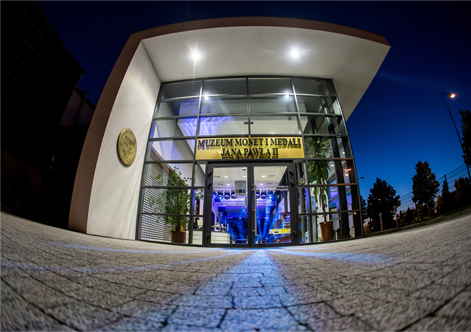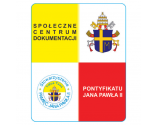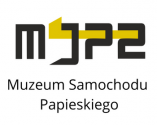
About John Paul II
Karol Wojtyła, known as John Paul II since his October 1978 election to the papacy, was born in Wadowice, a small city 50 kilometres from Cracow, on 18th of May 1920. He was the second of two sons born to Karol Wojtyła and Emilia Kaczorowska. His early life was marked by great loss. His mother died in 1929. His eldest brother Edmund, a doctor, died when he was 12 and his father, a non-commissioned army officer died in 1941.
He made his First Holy Communion at age 9 and was confirmed at 18. Growing up, John Paul was athletic and enjoyed skiing and swimming. He went to Kraków's Jagiellonian University in 1938 where he showed an interest in theater and poetry. The school was closed the next year by Nazi troops during the German occupation of Poland and young Karol had to work in a quarry (1940-1944) and then in the Solvay chemical factory to earn his living and to avoid being deported to Germany.
In 1942, aware of his call to the priesthood, he began courses in the clandestine seminary of Cracow, run by Cardinal Adam Stefan Sapieha, archbishop of Cracow. At the same time, Karol Wojtyła was one of the pioneers of the "Rhapsodic Theatre", also clandestine.
After the Second World War, he continued his studies in the major seminary of Cracow, once it had re-opened, and in the faculty of theology of the Jagiellonian University, until his priestly ordination in Cracow on 1st of November 1946.
Soon after, Cardinal Sapieha sent him to Rome where he worked under the guidance of the French Dominican, Garrigou-Lagrange. He finished his doctorate in theology in 1948 with a thesis on the topic of faith in the works of St. John of the Cross. At that time, during his vacations, he exercised his pastoral ministry among the Polish immigrants of France, Belgium and Holland.
John Paul II returned to his native Poland in 1948 and served in several parishes in and around Krakow. He was chaplain for the university students as well until 1951, when he took up again his studies on philosophy and theology. In 1953 he defended his habilitation thesis on "evaluation of the possibility of founding a Christian ethic on the ethical system of Max Scheler" at the Faculty of Theology of Jagiellonian University (It was the last habilitation before closing the Faculty by comunist goverment). Later he became professor of moral philosophy and social ethics in the major seminary of Cracow and in the Faculty of philosophy at the Catholic University of Lubin (where he became the Director of the Chair of Ethic, and lectured for 25 years until his election for the Pope in 1978).
On July 4, 1958, he was appointed Auxiliary Bishop of Cracow by Pope Pius XII, and was consecrated September 28, 1958, in Wawel Cathedral, Cracow, by Archbishop Baziak. Six years later on 13th January 1964, he was nominated Archbishop of Cracow by Pope Paul VI.
Considered one of the Catholic Church's leading thinkers, he participated in the Second Vatican Council—sometimes called Vatican II. The council began reviewing church doctrine in 1962, holding several sessions over the course of the next few years. As a member of the council, John Paul II helped the church to examine its position in the world. Well regarded for his contributions to the church, John Paul was made a cardinal in 1967 by Pope Paul VI.
On 16th of October 1978, John Paul made history by becoming the first non-Italian pope in more than four hundred years. As the leader of the Catholic Church, he traveled the world to spread his message of faith and peace. He has completed 95 pastoral visits outside of Italy and 142 within Italy. As Bishop of Rome he has visited 301 of the 334 parishesisiting. But he was close to home when he faced the greatest threat to his life. In 1981, an assassin shot John Paul twice in St. Peter's Square in Vatican City. Fortunately, he was able to recover from his injuries and later forgave his attacker.
A vocal advocate for human rights, John Paul often spoke out about suffering in the world. He held strong positions on many topics, including his opposition to capital punishment. A charismatic figure, John Paul used his influence to bring about political change and is credited with the fall of communism in his native Poland. He was not without critics, however. Some have stated that he could be harsh with those who disagreed with him and that he would not compromise his hard-line stance on certain issues, such as contraception.
From 1978 the Holy Father has presided at 15 Synods of Bishops: six ordinary (1980, 1983, 1987, 1990, 1994, 2001), one extraordinary (1985) and eight special (1980, 1991, 1994, 1995, 1997, 1998[2] and 1999).
His principal documents include 14 encyclicals, 13 apostolic exhortations, 11 apostolic constitutions and 42 apostolic letters. The Pope has also published three books : "Crossing the Threshold of Hope" (October 1994); "Gift and Mystery: On the 50th Anniversary of My Priestly Ordination" (November 1996) and "Roman Tryptych - Meditations", a book of poems (March 2003).
John Paul II has presided at 138 beatification ceremonies (1,310 Blesseds proclaimed) and 48 canonization ceremonies (469 Saints) during his pontificate. He has held 8 consistories in which he created 201 cardinals. He has also convened six plenary meetings of the College of Cardinals.
In his later years, John Paul's health appeared to be failing. At public appearances, he moved slowly and seemed unsteady on his feet. He also visibly trembled at times. One of his doctors also disclosed that John Paul had Parkinson's disease, a brain disorder often characterized by shaking, in 2001. But there was never any official announcement about his illness from the Vatican.
John Paul II died on April 2, 2005, at the age of 84, at his Vatican City residence. More than 3 million people waited in line to say good-bye to their beloved religious leader at St. Peter's Basilica before his funeral on 8th of April.
On July 5, 2013, waving the usual five-year waiting period, the Vatican announced that the Roman Catholic Church would declare Pope John Paul II a saint, and that the canonization ceremony would likely take place within the next 16 months. The Vatican also stated that Pope John XXIII, who headed the Catholic Church from 1958 until his death in 1963 and convened the Vatican II council, would also be declared a saint.
On September 30, 2013, Pope Francis announced that the canonizations of Pope John Paul II and Pope John XXIII would occur on April 27, 2014. The announcement of Pope John Paul II's canonization came after the Vatican revealed that two miracles were attributed to the late pope. After a dying French nun, Sister Marie Simon-Pierre Normand, prayed to Pope John Paul II for during her battle with Parkinson's disease—the same illness that killed the pope—she was cured. The second miracle involved a 50-year-old woman, who claimed that she was cured of a brain aneurysm after a photograph of Pope John Paul II spoke to her.
The official sainthood ceremony, held on April 27, 2014, brought together four popes. Pope Francis led the event to elevate Pope John Paul II and Pope John XXIII to sainthood, which was also attended by Francis's predecessor Emeritus Pope Benedict.
There are so many things we can say about John Paul II. Lots of them were already said or written and it's quite difficult to add something not known by many. However there is one interesting curiosity that hardly anyone knows. During Pope's John Paul II funeral Cardinal Camerlengo put inside the coffin little pouch with 26 silver medals in it. He did that just before coffin was closed. Those medals had special meaning, they were annual medals. Each one of them was made every year of Pope's pontificate as reflection of the most important events which took place during the previous year of papacy. This is long-held tradition. John Paul II was pope for almost 27 years, however there was only 26 medals. That happened because Vatican is striking annual medals on 29th of June on Saint Peter's and Saint Paul's Feast day every year. And as we know John Paul II became the pope in October and died in April. You could see all his annual medals during beatification ceremony May 1, 2011. They were displayd in the pictures placed arround colonnade on Saint Peters Square. They are timeless evidence of greatness of our Pope.
In our Museum you can see them all in various ores. Every year Vatican strikes 1000 specimens in gold and 6000 specimens in silver and bronze. Only in 2000 there was twice as many. When some of them aren't sold till the end of the year they are melted and used to create new ones in the following year. In our Museum we have full collection including all sets for all 26 years.

John Paul II saint from
See directions














